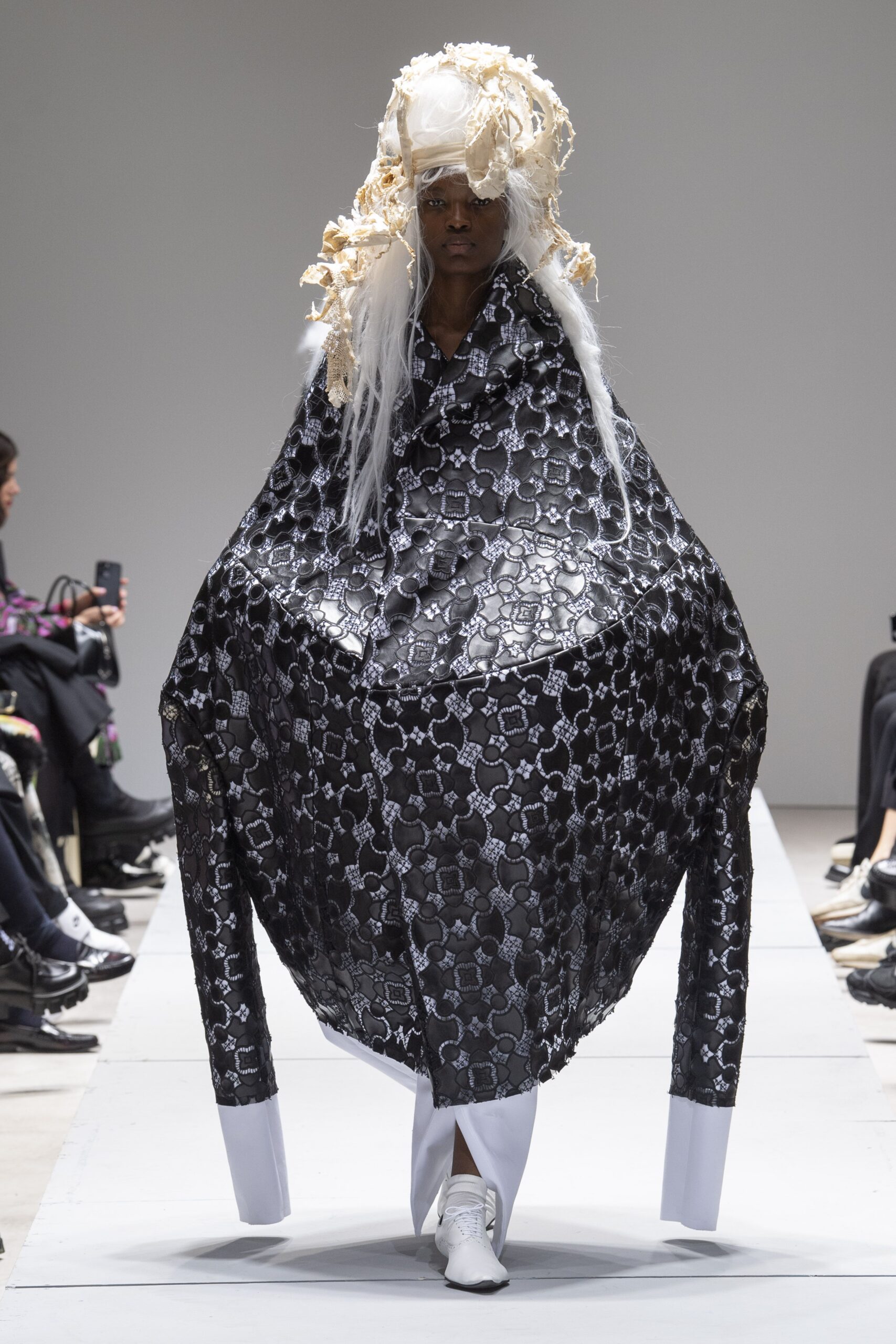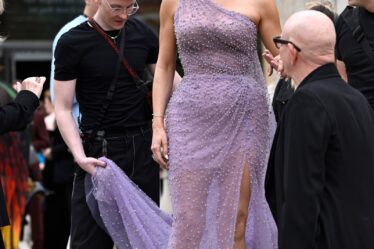
PARIS – Saturday was Japan Day in Paris: Junya Watanabe first thing, Noir Kei Ninomiya at midday, and Comme des Garçons, the mothership, in late afternoon. Enough breathing space between the three shows to absorb their challenging and uniquely different propositions, but also to reflect on the connective threads of Japanese fashion. The influence of Western dress during the Meiji period in the late 19th and early 20th centuries left a legacy of tailored Victorian and Edwardian formality. The Allied occupation post-WWII injected a whole other style vocabulary — jazz, jeans, leather jackets, youth cults — then came the wave of designers who osmosed all that Western jive with traditional Japanese ideas, like wabi-sabi, the embrace of the imperfect and incomplete. The result has been an enduring avant-garde which, fifty years after Issey Miyake first showed in Paris, continues to deliver intelligent, provocative and often beautiful ripostes to fashion orthodoxy.
Junya Watanabe’s mutations of Western pop culture have been responsible for some of my favourite shows over the years, especially the “Travis Bickle” men’s collection from Winter 2006. For Spring 2023, he imagined London’s New Romantics teleported to now. But if that promised an updated version of Steve Strange’s redictable detour. Eugene Souleiman’s hair for the first look was the clue: a huge, teased, florid red coxcomb that instantly summoned to mind the strange living creature named Martin Degville. Pop completists will recognise him as the creative engine behind Sigue Sigue Sputnik. But it was Junya’s genius that transposed the Flash Gordon camp of Sigue with the similarly exaggerated self-absorption of Goth: two narcissistic youth cults for the price of one.
The message of the collection was felt-tipped into a pair of heavily worked Levi’s: You can be whatever you want, particularly if that was Siouxsie Sioux on the cover of The Face in February 1982 or the kids lining up six months later to get into the Batcave, birthplace of Goth. In fact, Junya made his own club atmosphere, with the same purple strip lighting some of us remember from misspent youths. At the end of the show, the music was turned off abruptly and the lights went out, telling you it was closing time. Just like those old clubs. Funny ha-ha.
Michel Gaubert’s soundtrack whipped up an enthusiastic aural froth of Duran Duran and Japan the band, but Junya’s clothes went darker than that. Shoulders were sci-fi, proportions exploded into swirling capes and elongated drapes over leggings, latex, sequined or shredded, like Dracula’s brides gone clubbing. The iconoclasm innate to Japan’s contemporary fashion lexicon owes a profound debt to Vivienne Westwood. (In fact, wherever it exists in the world, fashion iconoclasm usually owes her a royalty). It’s hard to see the plaids, the chains, the rips and zips, even the strings of pearls (Viv loved the Queen) without thinking of her transmutations of British tradition. And so it was here. Junya didn’t miss a trick. Punks, Goths and New Romantics all appreciated speed as a cheap and efficient high. Listed collaborators for this collection included the likes of McLaren, Honda and Komine, a Japanese company which makes gear for motorbike racers. Maybe not exactly what the club kids had in mind, but go-fast just the same.
Noir’s Kai Ninomiya, a former patternmaker at Comme des Garçons, comes from – or rather, goes to – another place. He described his new collection as “a mystical journey through the depth of the noir universe.” If you could imagine a designer researching their latest looks through the lens of the James Webb space telescope, that designer might be Ninomiya. Coils of dark matter sparkled, quarks and fractals glittered, the trajectories of constellations were mapped in a cloud of shivering silver wires. The last look was an astral fairy cloaked in a cascade of evanescent star trails.
But the Noir universe was also grounded in more terrestrial terrain, courtesy of a collaboration with Hunter boots, and ceramic headpieces by the artist Takuro Kuwata. Wabi-sabi is a cornerstone of his work. Here, he contributed objects that were a cross between crude crowns and collapsing cakes. But they imbued Ninoyima’s models with a surreally aristocratic quality, especially when matched with mad-hatter hairstyles that looked like Marie Antoinette dragged backwards through a hedge.
There were elements of that tailored Edwardian formality I mentioned: jackets in houndstooth, britches in Prince of Wales check, high-necked blouses, long skirts. But they were twisted, caged, corseted. At its vexing best, Japanese fashion has an inscrutable alienness, and Ninoyima is an excellent ambassador for the alien.
Though he has nothing on his mentor Rei Kawakubo. The Mistress of the Cryptic has lately taken to elaborating ever so slightly on the clothes she presents and, to a reassuring degree, her proclamations dovetail with her designs. “A lamentation for the sorrow in the world today,” were the words that arrived with her new collection. Followed by “a feeling of wanting to stand together.”
The twin poles of despair and hope were so hopelessly entangled in the actual clothing that it was hard to extract one from the other. Kawakubo has tended to steer clear of the polemic in her designs, allowing them to exist outside social or political comment, but it has been kind of wonderful to see her engage more with the world. A few things instantly stood out in this show. One was that the models wore helmet or crown-like headgear, and it was my extremely erudite colleague Luke Leitch who identified them as virgin’s crowns, or crants, in which maidens were once buried. (Hamlet’s Ophelia was interred in a crant, said Shakespeare.) The other was that the stately soundtrack was by Greek composer Eleni Karaindrou, who scored “Mad Max:Fury Road.” I sat through the show looking at the pretty young models with their streaming white tresses and their outfits composed of lace glossed with black oil slicks and defensive carapaces of fabric and brocade bedspreads folded into skirts and shirts turned upside down so that collars were hems, and I thought that these were women at the end of the world, making the very best of what they had and learning to triumph in the face of hellish adversity. And they would triumph.
So that is what the very best of Japanese design can leave you thinking at the end of what is ultimately just a parade of new clothes to fill the new season’s demands. And nobody does it better.



